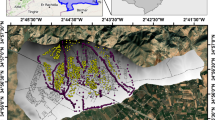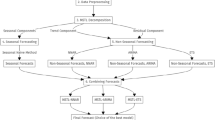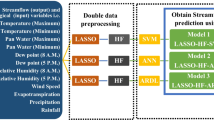Abstract
In this paper, an M–EEMD–ELM model (modified ensemble empirical mode decomposition (EEMD)-based extreme learning machine (ELM) ensemble learning paradigm) is proposed for landslide displacement prediction. The nonlinear original surface displacement deformation monitoring time series of landslide is first decomposed into a limited number of intrinsic mode functions (IMFs) and one residual series using EEMD technique for a deep insight into the data structure. Then, these sub-series except the high frequency are forecasted, respectively, by establishing appropriate ELM models. At last, the prediction results of the modeled IMFs and residual series are summed to formulate an ensemble forecast for the original landslide displacement series. A case study of Baishuihe landslide in the Three Gorges reservoir area of China is presented to illustrate the capability and merit of our model. Empirical results reveal that the prediction using M–EEMD–ELM model is consistently better than basic artificial neural networks (ANNs) and unmodified EEMD–ELM in terms of the same measurements.









Similar content being viewed by others
References
Chen FL, Ou TY (2011) Sales forecasting system based on Gray extreme learning machine with Taguchi method in retail industry. Expert Systems with Applications 38:1336–1345
Chen HQ, Zeng ZG (2011) Deformation prediction of landslide based on genetic-simulated annealing algorithm and BP neural network. In: Proceedings of the fourth international workshop on advanced computational intelligence, Wuhan, China, pp 675–679
Drucker H, Cun YL (1992) Improving generalization performance using double backpropagation. IEEE Trans Neural Netw 3(6):991–997
Feng GR, Qian ZX, Dai NJ (2012) Reversible watermarking via extreme learning machine prediction. Neurocomputing 82:62–68
Guo ZH, Zhao WG, Lu HY, Wang JZ (2012) Multi-step forecasting for wind speed using a modified EMD-based artificial neural network model. Renew Energy 37:241–249
Guzzetti F, Reichenbach P, Cardinali M, Galli M, Ardizzone F (2005) Probabilistic landslide hazard assessment at the basin scale. Geomorphology 72:272–299
Hornik K (1991) Approximation capabilities of multilayer feedforward networks. Neural Netw 4(2):251–257
Huang GB (2003) Learning capability and storage capacity of two-hidden-layer feedforward networks. IEEE Trans Neural Netw 14(2):274–281
Huang GB, Babri HA (1998) Upper bounds on the number of hidden neurons in feedforward networks with arbitrary bounded nonlinear activation functions. IEEE Trans Neural Netw 9(1):224–229
Huang GB, Chen L, Siew CK (2006a) Universal approximation using incremental constructive feedforward networks with random hidden nodes. IEEE Trans Neural Netw 17(4):879–892
Huang GB, Zhu QY, Siew CK (2006b) Extreme learning machine: theory and applications. Neurocomputing 70(1–3):489–501
Huang NE, Shen Z, Long SR, Wu MC, Shih HH, Zheng Q, Yen NC, Tung CC, Liu HH (1998) The empirical mode decomposition and the Hilbert spectrum for nonlinear and nonstationary time series analysis. Proc R Soc A Math Phys Eng Sci 454:903–995
Jaroudi AE, Makhoul J (1990) A new error criterion for posterior probability estimation with neural nets. In: Proceedings of iteration joint conference on neural networks, pp 185–192
Kaunda RB (2010) A linear regression framework for predicting subsurface geometries and displacement rates in deep-seated, slow-moving landslides. Eng Geol 114:1–9
Kawabata D, Bandibas J (2009) Landslide susceptibility mapping using geological data, a DEM from ASTER images and an artificial neural network (ANN). Geomorphology 113:97–109
Melchiorre C, Matteucci M, Azzoni A, Zanchi A (2008) Artificial neural networks and cluster analysis in landslide susceptibility zonation. Geomorphology 94:379–400
Msilimba GG (2010) The socioeconomic and environmental effects of the 2003 landslides in the Rumphi and Ntcheu Districts (Malawi). Nat Hazards 53:347–360
Nefeslioglu HA, Gokceoglu C, Sonmez H (2008) An assessment on the use of logistic regression and artificial neural networks with different sampling strategies for the preparation of landslide susceptibility maps. Eng Geol 97:171–191
Pradhan B, Lee S (2009) Landslide risk analysis using artificial neural network model focussing on different training sites. Int J Phys Sci 4(1):1–15
Pradhan B, Lee S, Buchroithner MF (2010) A GIS-based back-propagation neural network model and its cross-application and validation for landslide susceptibility analyses. Comput Environ Urban Syst 34:216–235
Qin SQ, Jiao JJ, Wang SJ (2001) The predictable time scale of landslides. Bull Eng Geol Environ 59(4):307–312
Qin SQ, Jiao JJ, Wang SJ (2002) A nonlinear dynamical model of landslide evolution. Geomorphology 43:77–85
Sun ZL, Choi TM, Au KF, Yu Y (2008) Sales forecasting using extreme learning machine with applications in fashion retailing. Decision Support Syst 46:411–419
Sorbino G, Sica C, Cascini L (2010) Susceptibility analysis of shallow landslides source areas using physically based models. Nat Hazards 53:313–332
Tamura S, Tateishi M (1997) Capabilities of a four-layered feedforward neural network: four layers versus three. IEEE Trans Neural Netw 8(2):251–255
Wu ZH, Huang NE (2009) Ensemble empirical mode decomposition: a noise-assisted data analysis method. Adv Adapt Data Anal 1(1):1–41
Xu F, Wang Y, Du J, Ye J (2011) Study of displacement prediction model of landslide based on time series analysis. Chin J Rock Mechan Eng 30(4):746–751
Yu L, Wang SY, Lai KK (2008) Forecasting crude oil price with an EMD-based neural network ensemble learning paradigm. Energy Econ 30:2623–2635
Zhu QY, Qin AK, Suganthan PN, Huang GB (2005) Evolutionary extreme learning machine. Pattern Recogn 38(10):1759–1763
Zong WW, Huang GB (2011) Face recognition based on extreme learning machine. Neurocomputing 74:2541–2551
Acknowledgments
The work is supported by the Natural Science Foundation of China under Grant 60974021 and 61203286, the 973 Program of China under Grant 2011CB710606, the Specialized Research Fund for the Doctoral Program of Higher Education of China under Grant 20100142110021.
Author information
Authors and Affiliations
Corresponding author
Rights and permissions
About this article
Cite this article
Lian, C., Zeng, Z., Yao, W. et al. Displacement prediction model of landslide based on a modified ensemble empirical mode decomposition and extreme learning machine. Nat Hazards 66, 759–771 (2013). https://doi.org/10.1007/s11069-012-0517-6
Received:
Accepted:
Published:
Issue Date:
DOI: https://doi.org/10.1007/s11069-012-0517-6




